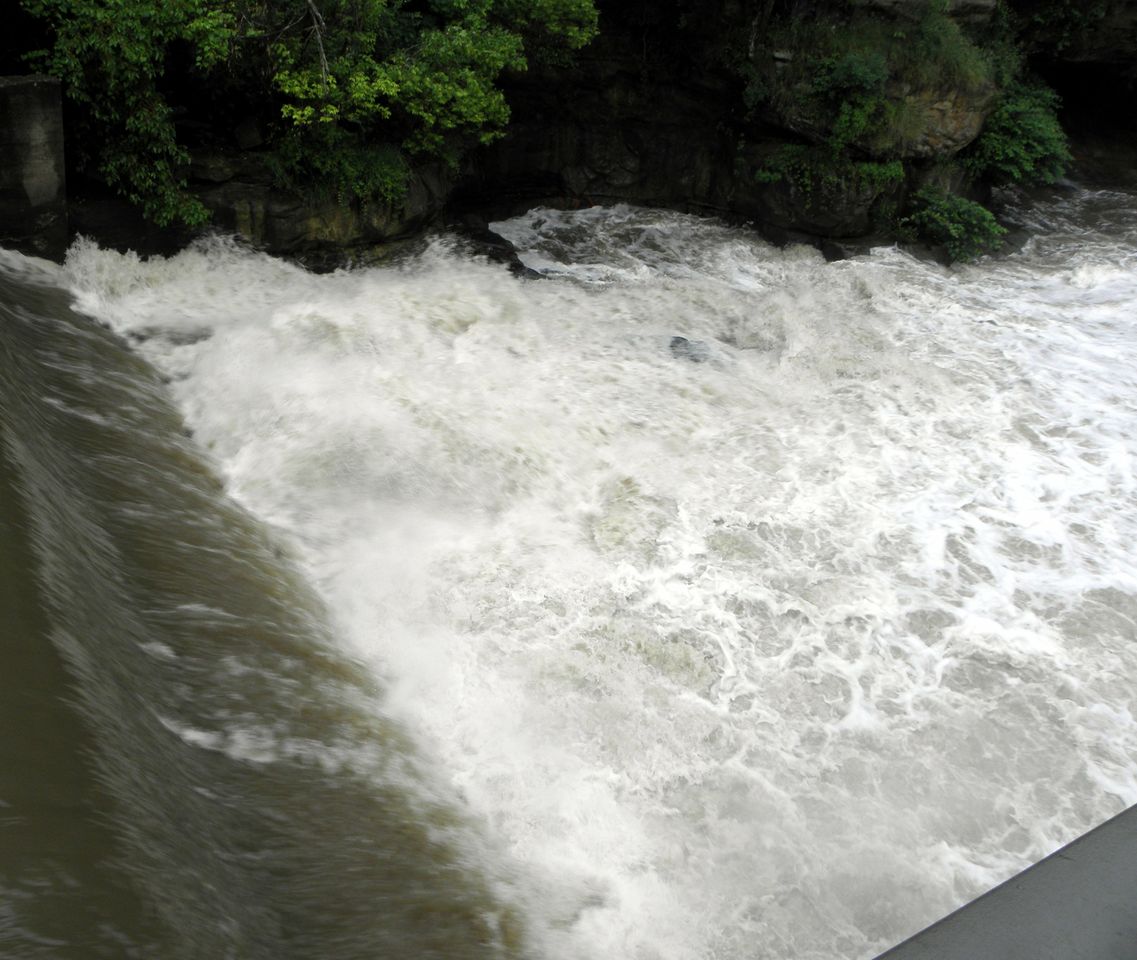
The new free-flowing Cuyahoga River will be prime territory for white-water kayakers. Photo: Karen Schafer
Listen to the story here…
SCHAEFER Dam Removal GL Echo by Great Lakes Echo
…while watching the Dam Cam live.

Karen Schaefer is an Ohio freelance journalist and independent radio producer.
Or follow the script:
By Karen Schaefer
Improving water quality for fish and other wildlife is the goal of a one-million dollar project to remove two river dams in the city of Cuyahoga Falls, Ohio this summer. Removal of obsolete dams is increasing across the Great Lakes region. Independent reporter Karen Schaefer says Ohio supporters believe taking down the dams will not only improve water quality, but provide new recreation opportunities for residents and visitors, and boost the local economy.
AMBI: Sound of water over Sheraton Falls, under:
SCHAEFER: This sound — the sound of water pouring over the Sheraton dam in Cuyahoga Falls — is about to become history. And that gives Bill Zawiski a sense of accomplishment.
ZAWISKI: It’s going to be neat, people are going to be here and it’s going to be fun.
SCHAEFER: Zawiski is a biologist with the Ohio Environmental Protection Agency. He’s been working for 15-years to get the dams torn down. Zawiski is standing on a deck overlooking the 11-foot high dam on the Cuyahoga River at the riverside Sheraton hotel in the heart of Cuyahoga Falls. Upstream, just out of sight, is the Le Fever dam, also slated for demolition. Both were built beginning in 1914 to power paper, rubber, copper and steel mills that are long gone. Zawiski says dams and the slow-moving pools they create are a serious problem for fish and the aquatic insects they feed on.
ZAWISKI: The water that’s underneath the flowing water on top loses oxygen. So you have this devoid area of oxygen and when it gets, we call it anoxic, it can have different chemicals like hydrogen sulfide. And those chemicals are toxic to aquatic life.
SCHAEFER: And so these dams are coming down. But not all at once. Joel Bingham is a aquatic biologist with EnviroScience, the company hired to do the demolition.

Demolition experts have already torn down enough of the old dam that water is no longer flowing over the top. Photo: Karen Schaefer.
BINGHAM: We’re going to drop in a barge that’s going to float a track-hoe machine, similar to an excavator that you’d see digging a ditch. It’s going to use a special attachment, a jack hammer attachment. We’re going to float that barge down to the dam and stabilize it with cables and other devices. And we’re going to start chipping away at the dam.
SCHAEFER: Bingham says sediments behind the dams have been tested for contaminants and judged safe for release to the river. While the old powerhouse structures on the west side of the Sheraton dam will remain, both dams will be completely removed. And Cuyahoga Falls city engineer Tony Demasi says that will change the flow — and the look – of the river.
DEMASI: Everyone in the city has always seen a dam in the river. They don’t remember a time when the dam wasn’t there. And so there’s some anticipation, there’s some curiosity and so we try to help people along with that process and assure them that the final product is going to be what nature intended this river to be anyway.
AMBI: Sound of Cuyahoga downstream, fade out under:
SCHAEFER: What nature intended is lower water levels that fluctuate with the seasons. Downstream of the two dams, the Cuyahoga races through a narrow sandstone gorge over bedrock and boulders, churning the river into white water. Some kayakers have already been braving the falls for this white water experience. Cuyahoga Falls Mayor Don Robards says in recent years, the city has seen major development of new housing and shops along the river’s edge. But with the dams removed – at no cost to the city thanks to a grant from the Ohio EPA – he also expects an increase in river recreation and tourism.

Guests at the Cuyahoga Falls Sheraton will soon see a new view of the dam-free Cuyahoga River. Photo: Karen Schaefer
ROBARDS: The kayaking and rafting for this are are unique, because they’re saying, once you hit this area right here, they’re rating it as potentially a Class 4, Class 5. The next area is down in West Virginia. So we see people from all of Northeast Ohio and maybe beyond, they’re going to be staying overnight, they’re going to want to kayaking and canoeing and those kinds of thing here, because of the treacherous terrain.
SCHAEFER: But it won’t all be treacherous. In recent years, Cuyahoga Falls has built new riverside boardwalks, paths, and several parks that get people closer to the river. Ohio EPA’s Bill Zawiski says the new dam-free Cuyahoga will be even more user-friendly.
ZAWISKI: In this area between the two structures, really Broad Street to Portage Trail, the river will be wade-able and I anticipate people will probably walk in there. I do.
SCHAEFER: Heavy rains have delayed removal of the dams in Cuyahoga Falls, but demolition is finally underway. City officials say people can watch on a city web cam or come to watch in person as the dams come down. For Ohio Public Radio/for Great Lakes Echo, I’m Karen Schaefer.
Related story: Michigan pulls the plug on dams
Karen Schaefer’s series on Northeast Ohio/Great Lakes water quality – Drink, Fish, Swim — is supported by a grant from the Burning River Foundation.
